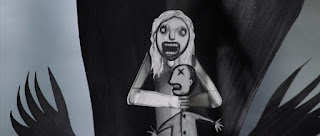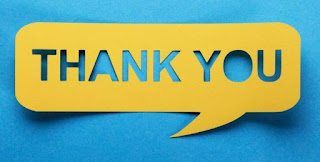Mothers in Horror Films
NOTE: This blog entry contains plot points for several horror films that may be considered spoilers. Some of these films include Psycho, The Shining, The Others, The Babadook, and Barbarian. Read at your own risk.
 |
| From The Babadook (2014) |
Outside of October, I don't typically watch horror movies; I'm a wimp, and jump scares work on me far too well. But Halloween is one of my very favorite holidays, so at least one horror novel or film feels essential to the season.
Despite my somewhat-squeamish nature, I also thought a horror film would be a nice break from obsessing about motherhood. After all, not only am I taking care of my now seven-month-old all day during the week, but I've also been recently reading The Montessori Baby and Raising Your Spirited Baby. That's a lot of baby-focusing, so I decided that turning on the new 2022 horror film Barbarian would be a change of theme.
Imagine my surprise when it wasn't! I'll try and keep this spoiler-light in terms of the story of the film's antagonist, but I will say that the being terrorizing the film's protagonists (again, won't give the specifics; it's awfully disturbing though) is referred to only as The Mother. A vintage breastfeeding VHS is a recurring motif in the story. And, at one point, the line is said, "Don't you see? She wants you to be her baby."
 |
| A closeup of the breastfeeding VHS in Barbarian |
The reveal of how central a twisted concept of motherhood is to this movie was enough to make me shake my head and laugh, despite the disturbing nature of the film, at the sheer irony.
When I finished the film (and I will admit that I fast-forwarded through many scenes; I did mention that I'm squeamish and that the movie was disturbing, right?), I thought a bit about how motherhood is used in the genre of horror. From the classic to the contemporary, motherhood and horror films have been strangely intertwined.
There are a few common depictions of mothers and motherhood in film that I've isolated. Let's light the campfire, get out the flashlight, and break them down!
The Unsettling Not-Mother
The Mother antagonist in Barbarian falls into this category, so it seems fitting to start here. This is the mother-figure who is somehow twisted, not actually a mother but instead a kind of horrific parody. Think of that feeling as a child when you may have grabbed the leg of someone you thought was your mother... and the feeling of shock and horror when you realized it was instead someone else. This category in horror films is that childhood feeling cranked up to 11. Besides The Mother antagonist in Barbarian, this feeling of an unsettling Not-Mother is what the protagonists of Goodnight Mommy seem to fear, and it's what makes the Button-Eyed mother terrifying in the children's horror film Coraline. This category takes what should be comforting, nurturing, or protecting and twists it to become something disturbing, threatening, or even harmful.
 |
| From Coraline (2009) |
The Mother as the Controller and Origin of Evil
This is the classic category of mothers in horror. Leila Latif in one article describes this trope as "the evil shrew who through her abusive parenting creates the evil antagonist." This occurs in Psycho; though Norma Bates is revealed to be dead by the time the movie takes place, Dr. Richman notes in his analysis of Norman's murders, "His mother was a clinging, demanding woman." While Norman is described as "dangerously disturbed," his mother's controlling nature is considered a part of his horrific origins.
 |
| From Psycho (1960) |
The Mother as Victim
This category describes the mother who is killed or victimized; she may be terrorized throughout the film, such as in Rosemary's Baby, be an early death in the film, or even be killed before the movie begins. In Scream, for example, the death of Sidney Prescott's mother looms large over the story, and Sidney's own terrors in the film are directly linked to her mother's tragic murder.
In the 2019 sequel to IT, the audience learns that Beverly's mother died when she was a baby, potentially via a postpartum suicide. Like most horrors in the town of Derry, the violence and feelings of despair may have been exacerbated by the supernatural presence of Pennywise. Beverly's childhood is defined by her father's abuse, which he excuses disturbingly with dialogue noting how much Bev looks like her mother. Beverly's own victimization is tied to her mother's death and own history as a victim (of domestic abuse and possibly supernatural influence).
 |
| From IT, Part 1 (2017) |
This category is essentially defined by the terrorized, dead, or absent mother; she is the one who could not protect herself and thus later could not protect her child.
The Mother as Warrior
This is the response to the Mother as Victim: what if that mother avoided the victim fate and was able to rise up to fight the evil attacking her and her family?
These mothers appear in a variety of films, including a number of modern haunted house movies, the 2006 horror video game movie Silent Hill, and the more recent A Quiet Place.
 |
| From Silent Hill (2006) |
Interestingly, Wendy Torrance in The Shining is often miscategorized as a Mother as Victim; Leila Latif categorized Wendy in her article on mothers in horror as "the screaming victim" and Stephen King has said as much about the film adaptation of his character as well. Many have described the film's depiction of Wendy as weak, potentially because of Shelley Duvall's soft voice and intense scream; however, as Jillian Cheney reminds her readers in the article "It’s Okay to Scream: In Defense of the Weeping Mothers of Horror," Wendy is triumphant. Not only does she survive, but she protects her son, which "is impressive, considering she goes head to head with a psychotic husband and a sentient hotel... [their] survival is triumphant." Rebecca McCallum similarly writes in The Evolution of Horror that Wendy is notably a proactive warrior by the film's third act, moving to take action for her safety and her child's:
"Wendy is also mindful to equip herself with the bat during the staircase scene where she again demonstrates great bravery. Cautioning him: ‘Stay away from me’ she is desperately confused and running out of options. After buying herself some time, she assesses the situation and assumes power by heroically making the first move. Swinging the bat, she hits Jack... and in doing so is the first of the two to administer a physical blow."
 |
| From The Shining (1980) |
And More...
In modern horror films, you also have some depictions of mothers and motherhood that cross between categories and subvert classic categorization. Two good examples of this are the films The Babadook and The Others.
The Babadook is an interesting film in that the monster is a direct allegory for the mother's depression and, perhaps more broadly, for "the unspeakable horrors of motherhood, ones that we’re only just beginning to de-stigmatize and discuss. The Babadook plays on the resentment [the mother] has for her [son], the loneliness she feels as she spends her life caring for his needs, and the way she feels she’s failing." As Kelcie Mattson explains further in her analysis of the film, the mother "wants to love [her son], but her depression keeps her from doing so. The Babadook is a representation of her illness made manifest."
In this way, the protagonist seems to fall into the Mother as Origin of Evil trope, since the creature symbolizes her own resentment and depression. However, with the help of her son, his support and his love, she is able to fight back the darkness and protect them both from the creature. Thus, with help, she becomes the mother Warrior as well.
The Others is the opposite intersection and subversion of tropes. In this 2001 film, the mother Grace seems to be the Warrior as she strives to protect her children from something seemingly haunting them and her home. She literally wields a shotgun in one scene, the picture image of the protective, action-taking mother focused on protecting her children.
 |
| From The Others (2001) |
Again, keeping it vague to avoid major spoilers, the movie soon makes clear that Grace is the reason for the "haunting," not only showing her to also be categorized as the Mother as Origin of Evil but also unsettlingly controlling and violent to the point of subverting motherly expectations.
There are so many different kinds of mothers in horror films, some of whom fit easily into one category and others who cross categories and play with the tropes. It is fascinating, though, how many more horror films than I realized center motherhood or use the twisting of mothering expectations to create further horror. As Michelle Mastro notes in a blog article for Indiana University, mothers in horror films have changed significantly over the years:
"Representations of mothers and mothering in horror have gone from religious authoritarian control freaks, to the single working mom protagonist, to modern day parents who make mistakes."
So, as you turn on that horror film to celebrate the fall holiday this year, perhaps pay attention to the mothers in the movie, whether she be a villain, a hero, or something else entirely. Who knows? Sometimes, a savior mother is just what a film needs to feel satisfying and comforting. But, in some cases, the most horrific thing a horror movie can do is make the one who is supposed to comfort you and keep away the monsters be the one who invites them into the house in the first place.
 |
| From The Babadook (2014) |
Happy Halloween, everyone!



Comments
Post a Comment